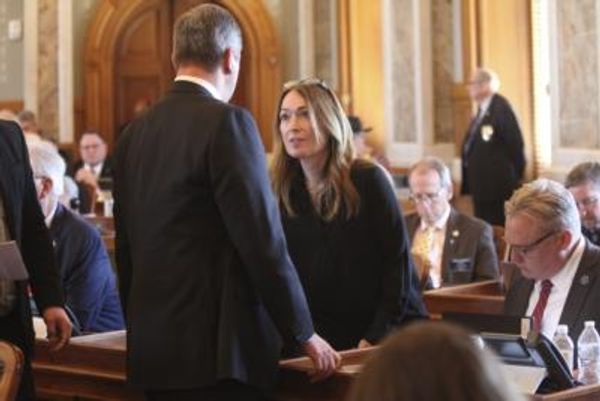
Anna Sorokin is sitting on a parapet on the roof of her fifth floor East Village walk-up, unperturbed by the sheer drop behind her – confidence, one might think, that came in handy during her rise from obscurity and then infamy as a fake New York City heiress known as Anna Delvey who captured Manhattan’s glitzy art scene.
It has been six years since she was arrested in Malibu, California, and almost four since a jury found her guilty of second-degree grand larceny, theft of services and one count of first-degree attempted grand larceny. Now Sorokin is back in New York and making news again.
A week after being granted a $10,000 bail by a federal immigration court, her every move is again being followed by paparazzi. Their attentions are rewarded by Sorokin, 31, when she leans from her window in a headscarf or on trips to see her parole officer in outfits that offer a glimpse of the black ankle monitor stipulated under the terms of her prison release.
CNN has already been round. “I only did it because I was going on after Biden,” Sorokin says of her interviewer, Jake Tapper, whose repeated attempts at extracting expressions of remorse for her actions were rebuffed.
“It was expected,” Sorokin says of this approach. “Certainly I have regrets about what I’ve done, and I would have maybe changed everything and not disappointed the people who believed in me.”

But she acknowledges that it took some time to arrive at this perspective. When she was released to Immigration Customs and Enforcement (Ice) 18 month ago, a window between Trump and Biden deportation policies gave the Russian-born German an opportunity to stay in the US.
“I’m grateful they gave me a second chance and an opportunity to set everything straight,” she says. “It took until I got out to realize how I’d affected people. My story became bigger than I am, and translated into people wanting me to be sorry or otherwise I would be glamorizing crime.”
It’s not hard to glean that fascination with Sorokin is as much about the onlooker as the subject. She was a young emigre who (briefly) attended Central Saint Martins in London to study fashion history, then interned in Paris for a biennial magazine, Purple, where she met the bad boys of the New York art scene and got an idea to open an arts foundation, with a private club and restaurant to monetize it.
Peggy Guggenheim and Gertrude Vanderbilt Whitney had similar notions. Only they came from great wealth and Sorokin did not. Nor was she whom she said she was.
As Tori Telfer surmised in last year’s “Confident Women” on the history of women con artists, Sorokin’s crime wasn’t about the power of an expensive handbag. Instead she had a deep awareness of the foibles of the wealthy – ‘the greed, the superficiality, the refusal to question the narrative of someone who claims to be somebody” – and the ability to climb the rungs of their social ladder in pursuit of her goals.
“I wasn’t selfless but I was not calculating in terms of personal gain,” Sorokin says in response. “I never just wanted to be seen as somebody, I wanted to be kind of judged by a successful project. It wasn’t just an influencer culture thing, it wasn’t to be famous to get attention, I wanted to make my mark”.
At trial, prosecutors claimed Sorokin had burned through $40,000 over a period of eight days and had “barricaded herself” in her room at the W hotel and demanded staff refill the minibar but not check it. Sorokin’s defense attorney insisted his client had been “buying time” and planned all along to settle her debts. He compared her to Frank Sinatra, saying “they both created their own opportunities” in New York.

But it had been Manhattan’s district attorney who branded Sorokin as a “fake heiress” – not something, Sorokin claims, that she’d come up with. But it was a short-hand for entitlement and that caught on. It’s one thing to be entitlement, another to pretend you are. “That’s the whole thing with the fake heiress game,” she says.
Sean Glass, co-creator of an Anna Sorokin podcast in the works, says his friend saw an attractive eco system of glamor and cool, and was confronted by people who said she couldn’t join unless she was an heiress. “So Anna exploited that absurdity,” Glass says. “It got messy of course.”
“I’m an unreliable narrator, so who is going to care what I say on the subject?” Sorokin interjects.
For now, Sorokin is court-ordered to remain in her apartment building. She’s paid back a $275,000 judgment using money from Inventing Anna – a strained Netflix series on her time in New York that she says she has not watched. But under the conditions of her release she is banned from social media , which puts a crimp in the NFT business she began in detention, and she faces deportation proceedings that could still go on for years.
“My position was always damage control,” she says. “I’ve been portrayed like I wanted to be famous or I cared about the money and the clothes and whatnot, when in fact I was just trying build a project. I’d met people who were doing things, so I was like why can’t I do the same? I was trying to create my own opportunities.”
Control is a word Sorokin uses frequently, especially in describing ambition. “I started off small, but then I wanted more control, to control what I do, because if you work for someone you don’t really get control of projects. It’s all about control.”
If the art project had been successful, she planned outposts in Los Angeles, Paris, London and Dubai. With each the power of the brand and its associations would increase, along with Sorokin as gatekeeper with “the power to curate who is going to get through the door”.
But the risky program came unstuck when her friend Rachel Williams, a photo editor at Vanity Fair, shopped her to authorities after the Morocco trip. That kicked off a period of institutionalization – at Twin Towers in Los Angeles, in New York at Rikers Island, Bedford Hills correctional, Albion correctional near the Canadian border, and for the past year and a half in in Ice custody in Orange county jail.
“It’s very like a high school. Sometimes you end up with a crew, sometimes you stick to yourself,” she says. “In America you get to go to jail for everything, a girl who starved her kid was together with us, parole violators, DUI people. I liked the old-timers, the older Black females, who’d been through so much. They were funny. They helped me figure it out.”

Sorokin took a prison job in the kitchens – culinary arts – where the supervisor put her on baking cakes and making peanut butter and chocolate chip cookies. “All kinds of unhealthy stuff. I taught them how to make an avocado mousse where you mix avocado, cream of coconut and cocoa.”
Finally she worked in the cafeteria, though, she adds, “they definitely would not let me be cashier”. But at no point “did anyone in authority sit me down and ask what went wrong and how can we make sure this doesn’t happen again”.
It’s still early days in the reinventing Anna story. America is, after all, famed for its second acts, and Sorokin says she hasn’t soured on the American dream. “I still feel like I’m in control of my story. I’m just trying to focus on what I can control and what I can create out of this situation.”







